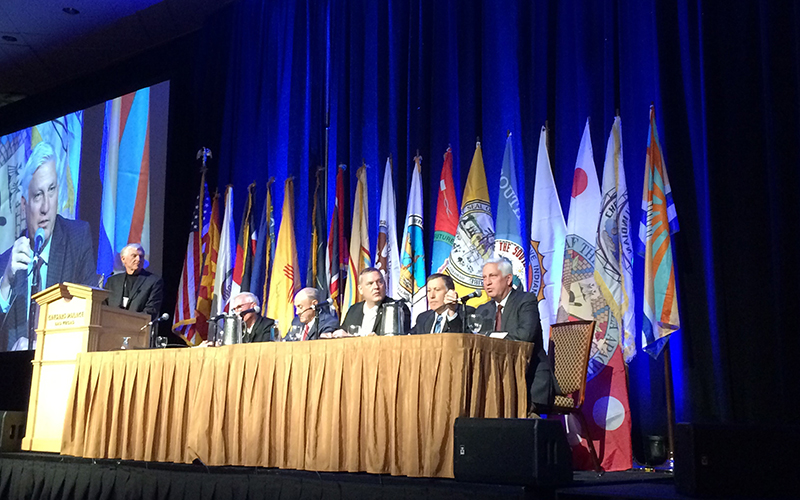
Researchers, decision makers and water users from across the Colorado River Basin will converge on Caesar’s Palace in Las Vegas starting Tuesday. The 76th annual conference is in the spotlight as the river steadily shrinks because of climate change and population growth. (Photo by Luke Runyon/KUNC)
The river that supplies water to 40 million people in the Southwest is alarmingly dry. Since the federal government declared a water shortage this summer for the first time, the Colorado River has been thrust into national headlines, and so have the scientists and decision makers who track and shape its future.
Next week, hundreds of them will gather under one roof for the first time since the shortage was declared in August. This will be the 76th time the Colorado River Water Users Association has met, but this year’s conference in Las Vegas will be under a new magnifying glass.
“This used to be more regional,” said John Entsminger, general manager of the Southern Nevada Water Authority. “Maybe occasionally a national story. But we saw people discussing the Colorado River as a case study in Glasgow. So there certainly is a lot more attention being paid to it.”
Entsminger was alluding to COP26, the United Nations climate conference held in Scotland this summer. Beyond the increased media attention – Entsminger said he’s done “dozens and dozens of interviews” with news outlets from all over the world – conditions in the basin are deteriorating more quickly than water managers had hoped, providing an inescapably urgent backdrop to discussions.
“It’s one thing to know something intellectually,” he said, “And then another thing, at least for us in Las Vegas, to see Lake Mead in your backyard drop that quickly.”
The meeting in Las Vegas brings together a wide array of groups who stake a claim to portions of the river’s water, which feeds homes, businesses and farms from Wyoming to Mexico, including seven states and 30 federally recognized native tribes.
Those groups are under increasing pressure to negotiate agreements that would allow the region to move forward while drawing from a shrinking water supply. The first such agreements were part of the Colorado River Compact, which was signed in 1922.
This summer’s shortage declaration was triggered by dropping levels in Lake Mead, but it’s the culmination of more than two decades of drought. Scientists say unprecedented heat, driven by human-caused greenhouse gas emissions, is causing a chain of effects that includes less snow, shorter, warmer winters, drier soil and parched rivers and streams.
At the same time, those who manage the region’s water are having to allocate that smaller supply in the face of growing demand. Cities from Denver to Phoenix to San Diego, including many with steadily growing populations, depend on water from the Colorado. Agriculture uses about 80% of the river’s water, and it increasingly has come into the crosshairs of public scrutiny.
Balancing the interests of different stakeholders is tricky, Entsminger said, but he cited several occasions since the turn of the millennium in which tense negotiations eventually found collaborative conclusions.
“Every one of those agreements was always on the brink of collapse because of adversarial animosity,” he said, “Right up until we all figured out that the only path to success was to work together.”
Looming over this conference will be the yet-undecided guidelines for managing the river after 2026, when the current rules expire. Those current rules, the 2007 Colorado River Interim Guidelines, were the first of their kind to address a future of water shortages in the basin.
While the exact terms of the 2026 guidelines are still being hashed out, the gravity of the diminishing supply is forcing some existential questions about water use. As states prepare their own strategies for negotiating with the rest of the basin, they’re balancing internal needs.
“All of the different interests across Colorado, whether that’s tribal interests, whether that’s environmental interests, whether that’s agricultural interests, recreational interests, rural economy issues – things like that are all coming into play right now,” said Becky Mitchell, director of the Colorado Water Conservation Board.
Mitchell said her agency’s priority is to emphasize the effects of drought on states in the Upper Basin, arguing that they are more at the whims of drought and climate change. Low snowpack and other hydrological factors can leave rivers and streams dry, straining water managers’ ability to meet their required allocations.

John Entsminger of the Southern Nevada Water Authority, shown third from right at the 2017 conference of the Colorado River Water Users Association, says this year’s gathering comes with a new level of urgency. (Photo by Luke Runyon/KUNC)
Arizona and other Lower Basin states, meanwhile, depend on water released from reservoirs. The Upper Basin is required to deliver a certain amount of water to Lake Mead each year, functionally assuring a steadier supply for those who draw from it.
“We’re feeling it every day,” Mitchell said. “But really making sure that people understand what is happening and what has been happening for the last 20 years in the Upper Basin, that’s going to be one of our priorities.”
Mitchell agreed that collaboration will be forged out of necessity.
“We have no choice but to get there,” she said. “It may be an ugly road. It may be bumpy. There may be some issues along the way, but that is the only option at this point.”
In the Lower Basin, some states are discussing a plan to leave more water in Lake Mead in 2022 and 2023. The deal involves water management agencies from Nevada, Arizona and California, as well as the Department of the Interior, and would put 500,000 acre-feet of water in the reservoir each year. An acre-foot is the amount of water needed to fill 1 acre of land to a height of 1 foot, which provides enough water for one to two households for a year.
The so-called “500+” plan would see those users drawing less from the Colorado River’s supply and is seen as a contingency effort to stop Lake Mead from dropping further to critically low levels. In addition to supplying water, the reservoir also must be full enough to produce electricity at Hoover Dam.
The plan would involve states cutting back their water usage before it’s required by federal mandate, and it sets fundraising goals for money that would be used to pay farmers, tribes and water agencies to reduce their use.
Entsminger said he’s optimistic the 500+ plan will be signed in Las Vegas.
“I do think there’s some substantive agreements that will come out of” the conference, he said, “but it’s also a chance for the river community as a whole to come together, assess where we are at this point and figure out a plan for moving forward.”